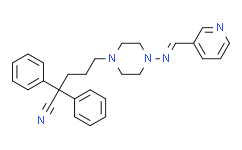| Cas No.: | 218136-59-5 |
| Chemical Name: | (E)-2,2-Diphenyl-5-(4-((pyridin-3-ylmethylene)amino)piperazin-1-yl)pentanenitrile |
| Synonyms: | (E)-2,2-Diphenyl-5-(4-((pyridin-3-ylmethylene)amino)piperazin-1-yl)pentanenitrile;SC-26196;(E)-2,2-diphenyl-5-(4-(pyridin-3-ylmethyleneamino)piperazin-1-yl)pentanenitrile;SC 26196 |
| SMILES: | N#CC(C1=CC=CC=C1)(C2=CC=CC=C2)CCCN3CCN(/N=C/C4=CC=CN=C4)CC3 |
| Formula: | C27H29N5 |
| M.Wt: | 423.55266 |
| Sotrage: | 2 years -20°C Powder, 2 weeks 4°C in DMSO, 6 months -80°C in DMSO |
| Description: | SC-26196 is a potent, orally active Delta6 desaturase (D6D) inhibitor (IC50=0.2 μM in a rat liver microsomal assay). Antiinflammatory properties[1]. |
| In Vivo: | SC-26196 ( included in the diet at 0, 0.07, 0.21, or 0.7 mg/kg diet to achieve dosages of 0, 10, 30, and 100 mg/kg per day) causes a decrease in the calculated Δ6-desaturase index in both adipose tissue and liver. Feeding 100 mg SC-26196 per kg BW per day inhibits the Δ6-desaturase enzyme[3]. Animal Model: Male mice (12- or 15-week-old)[3] Dosage: 0, 10, 30, and 100 mg/kg per day Administration: Included in the diet at 0, 0.07, 0.21, or 0.7mg/kg diet to achieve dosages of 0, 10, 30, and 100mg/kg per day. Result: Caused a decrease in the calculated Δ6-desaturase index in both adipose tissue and liver. |
| In Vitro: | IC50: 0.2 μM (Delta6 desaturase in a rat liver microsomal assay)[1] |

 DC Chemicals' products qualify for U.S. tariff exemptions. We guarantee no price increases due to customs duties and maintain stable supply, continuing to deliver reliable research solutions to our American clients.
DC Chemicals' products qualify for U.S. tariff exemptions. We guarantee no price increases due to customs duties and maintain stable supply, continuing to deliver reliable research solutions to our American clients.





















